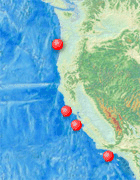 ©2020 Biological and Chemical Oceanography Data Management Office.
©2020 Biological and Chemical Oceanography Data Management Office.Funded by the U.S. National Science Foundation
EAGER: Initiation of a pH/pCO2-sensing mooring platform on the Oregon coast
Ocean acidification (OA), the progressive decrease in ocean pH as atmospheric carbon dioxide (CO2) dissolves in sea water, is a looming issue with impacts that are still uncertain, but may disrupt ocean ecosystems. This project will deploy accurate and precise in-situ sensors that will begin the development of pH and pCO2 time series off the central Oregon coast - a region that is amongst the mostly strongly impacted by corrosive upwelled waters within the California Current system. These sensors, in conjunction with lower-frequency ship-based calibration as well as horizontal and vertical samples, will provide a detailed and integrated look at the scope and impacts of accelerated biogeochemical changes in a coastal inner-shelf ecosystem that is currently unmonitored for carbonate chemistry shifts.
Intellectual Merit: Coastal waters in upwelling regions will experience some of the earliest and most severe onsets of ocean acidification. Already, limited field surveys suggest that the portions of the California Current system (CCS) are experiencing low pH conditions during the summer upwelling season. Determination of the direct and indirect impact of ocean acidification on marine calcifiers and other pH or pCO2 sensitive organisms depends critically on accurate assessments of both current OA stress regimes and the likely scope of future biogeochemical change. To date, we have virtually no such time series in the inner-shelf waters of upwelling shelves where the combined burdens of CO2 increase from anthropogenic and respiratory sources are maximal. This observational gap is a severe impediment to progress in the study of this major consequence of global climate change and its ecological consequences. This is due largely to the lack of accurate and reliable sensors that can be deployed in the field in inner shelf waters.
Recently, sensors for pH and pCO2 have been developed that are capable of providing the required accuracy, precision and reliability needed in instruments deployed in the challenging and dynamic environments of the inner shelf. For systems where biogeochemical signals are spatially heterogeneous, an important criterion for developing time series data is the ability to resolve spatial variations that are ecologically important and/or crucial for controlling for potential aliasing effects. OSU-PISCO (Oregon State University, Partnership for Interdisciplinary Studies of Coastal Oceans) has acquired funds for one sensor array, and in July 2009, will deploy the array on a mooring to begin the first pH and pCO2 time series in the inner shelf waters of the northern CCS. This EAGER project will allow deployment of a second sensor array.
The project has three goals: documenting spatial differences between pH and pCO2 between the two coastal sites, providing a contrasting monitored site for organismal and ecological impacts studies, and providing a regional "back-up" site in case of loss or failure of the first instruments. The expanded regional sensor array in Oregon will be linked to arrays at Bodega Marine Lab and in southern California to form the first stage of what we expect will be a west coast network of ocean acidification sensors. These will provide the first datasets available for establishing the contextual environmental information necessary for research on the ecological consequences of ocean acidification.
| Dataset | Latest Version Date | Current State |
|---|---|---|
| SH70 SAMI pCO2 from SH70 mooring 2009-MI_LOCO-Lander, 2010-MI_LOCO-Lander in the SH70 mid-shelf time series station (Strawberry Hill): 44.25N, 124.50W from 2009-2010 (EAGER project) | 2012-12-04 | Final no updates expected |
| Moorings metadata from coastal Oregon inner-shelf time series station (Lincoln Beach, Strawberry Hill) from 2009-2020 (EAGER project) | 2012-05-09 | Preliminary and in progress |

Principal Investigator: Bruce A. Menge
Oregon State University (OSU-PISCO)
Co-Principal Investigator: Francis Chan
Oregon State University (OSU-PISCO)
Project Coordinator: Kristen Milligan
Oregon State University (OSU)
Contact: Francis Chan
Oregon State University (OSU-PISCO)
BCO-DMO Data Manager: Stephen R. Gegg
Woods Hole Oceanographic Institution (WHOI BCO-DMO)
Partnership for Interdisciplinary Studies of Coastal Oceans [PISCO]